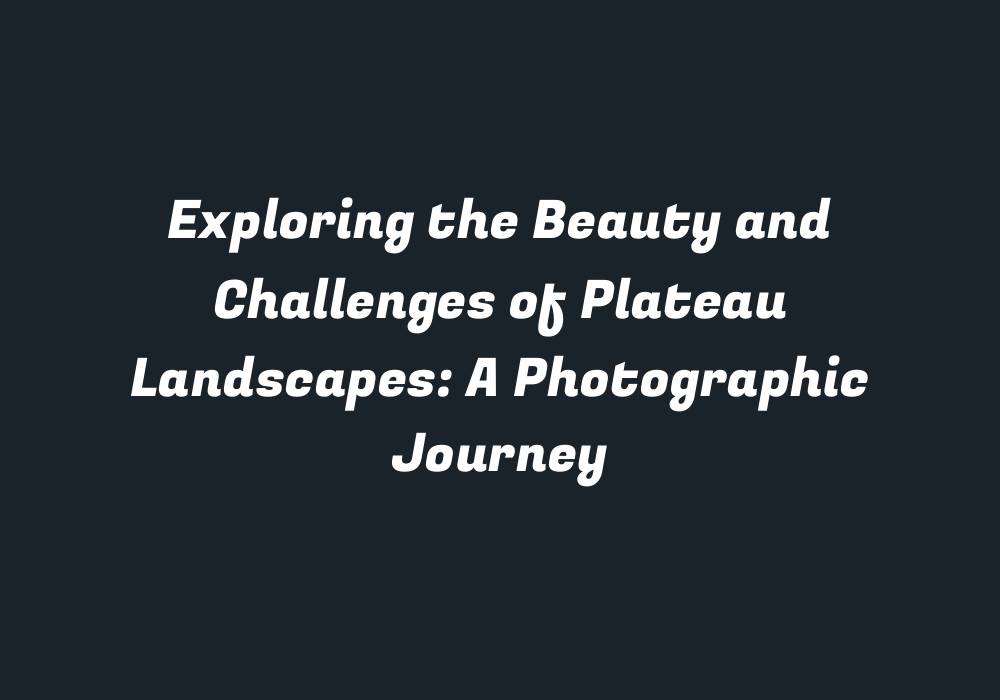Exploring the Beauty and Challenges of Plateau Landscapes: A Photographic Journey
Introduction
Plateaus are unique landforms characterized by their flat or nearly level expanses. Spanning across various geographical regions, they offer a captivating blend of beauty and challenges for both the photographers who capture their essence and the inhabitants that call these landscapes home. In this article, we delve into the mesmerizing allure and fascinating aspects of plateau landscapes through the lens of photography.
The Allure of Plateau Landscapes
Photography captures the essence of any landscape, reflecting its beauty, character, and essence in a single image. When it comes to plateaus, their distinctive features set them apart from other geographic regions.
Uniqueness of Plateau Landscape Photography
Firstly, the distinct horizontality of these landforms creates a visually compelling image. Capturing this unique attribute often requires an elevated position or perspective to emphasize the flatness of the terrain, revealing its vast expanse and allowing one to see how it connects with surrounding geographical elements. This provides photographers with opportunities to showcase both the horizon and the details of the landscape simultaneously.
Secondly, the topography of plateaus often features a variety of weather conditions and diverse plant life, providing an intriguing visual mix for photographic exploration. The combination of these factors creates rich and vibrant images that capture the essence of these lands.
Challenges in Photographing Plateau Landscapes
While there is much to be celebrated about plateaus, they can also pose specific challenges for both photographers and inhabitants. In this section, we discuss some of these issues.
Difficult Terrain
One of the main challenges associated with capturing the beauty of a plateau landscape is navigating its often rugged terrain. Many of these regions are located in remote areas with limited accessibility, requiring patience and determination to reach some of the most striking vantage points for taking photographs. Additionally, this difficult terrain may pose safety concerns when walking or hiking, especially during inclement weather or in the absence of proper equipment and preparation.
Weather Conditions
Plateaus can experience a wide range of temperatures and weather conditions throughout the year, making it challenging to capture their beauty consistently across different times. For instance, plateau regions with high altitudes might be prone to rapid changes in temperature and unpredictable weather patterns, which could affect the quality of photographs or limit the duration during which one can shoot in optimal conditions.
Capturing the Diversity of Plateau Landscapes
Plateaus are diverse in their geological structure and ecosystems. Therefore, capturing the entire range of these features demands a deep understanding of local ecology and geography. In some cases, this may require working with specialized equipment or techniques to ensure that all aspects of plateau landscapes can be accurately depicted in photographs.
Interacting with Local Populations
One must also consider the impact that their presence has on the local population when photographing plateaus. Many of these regions are inhabited by indigenous communities with distinct customs, traditions, and beliefs. It is essential to respect their culture and seek permission before capturing photographs, particularly if it involves individuals or sacred sites. This can create meaningful interactions and provide unique perspectives for viewers to appreciate the interplay between people and landscape in these areas.
Exploring Plateau Landscapes with Photography: Examples from Around the World
To better understand the beauty and challenges of plateau landscapes, let’s take a look at some real-world examples captured through photography:
1. The Tibetan Plateau: Spanning across the highest region on Earth, this plateau boasts breathtaking views of snow-capped mountains, glaciers, and vast grasslands. Photographers often capture its beauty during different times of the year, emphasizing the region’s diverse landscapes and weather conditions.
2. The African Rift Valley: Located in East Africa, this UNESCO World Heritage site features stunning views of the rift valley floor and surrounding mountains. The landscape showcases a diverse range of geological formations, wildlife, and vegetation, which can be challenging to capture in a single image but is an incredible experience for photographers willing to explore these unique environments.
3. The Bolivian Altiplano: This high-altitude plateau in South America features a breathtaking combination of Andean mountains, volcanic lakes, and a rich history dating back to the Inca Empire. Its unique blend of geography, culture, and natural beauty has inspired many photographers to capture its essence using innovative techniques and perspectives.
4. The Ethiopian Highlands: Located in the African continent’s central part, this region is characterized by its rugged terrain, diverse ecosystems, and a history steeped in ancient civilization. Photographing these highlands presents both challenges and opportunities for photographers to depict their beauty while simultaneously exploring their complex history and unique culture.
Conclusion
Plateau landscapes offer an incredible mix of geological features, cultural diversity, and visual appeal that can be difficult to capture through photography. By understanding the unique aspects of these regions, photographers can create striking images that showcase their beauty while acknowledging the challenges they face. Through this process, we gain a deeper appreciation for the wonders of plateau landscapes and the people who call them home.
